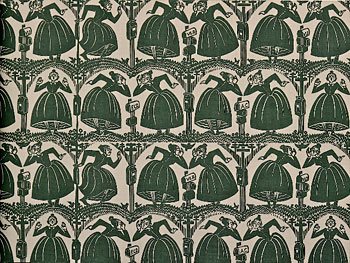THE FOLLY COVE DESIGNERS
 In addition to being a significant children’s book author/illustrator, Jinnee, as she was known to family and friends, was also a gifted textile designer. In 1938, she decided to make curtains for her studio using the traditional block print method. She chose linoleum because it was inexpensive and affixed it to wood blocks. The designs were cut into the linoleum, inked, and then printed on cotton fabric. At the time, Jinnee did not own a press so she printed the fabric by jumping up and down on the block. Her neighbor, Aino Clarke, a violinist, admired the curtains and asked Jinnee to teach her how to do block printing. Mrs. Clark offered violin lessons for Jinnee’s two sons,
In addition to being a significant children’s book author/illustrator, Jinnee, as she was known to family and friends, was also a gifted textile designer. In 1938, she decided to make curtains for her studio using the traditional block print method. She chose linoleum because it was inexpensive and affixed it to wood blocks. The designs were cut into the linoleum, inked, and then printed on cotton fabric. At the time, Jinnee did not own a press so she printed the fabric by jumping up and down on the block. Her neighbor, Aino Clarke, a violinist, admired the curtains and asked Jinnee to teach her how to do block printing. Mrs. Clark offered violin lessons for Jinnee’s two sons,
Aris and Mike, in exchange for design lessons. Soon, other neighbors wanted lessons and in 1940, the textile collective, The Folly Cove Designers, was established in Gloucester, Massachusetts. To distinguish her textile work from her work as a children’s book author/illustrator, Jinnee signed her work, Virginia Demetrios.
While styled after a medieval guild, the Folly Cove Designers departed from the tradition of signing only the name of the guild by adding the individual designer’s name to what was designed and printed by that individual. 1943, the designers acquired several Acorn presses used to pull prints. This no longer required them to jump up and down on the wood blocks, but it did require a great deal of physical stamina to pull the press.
The Folly Cove designers were established at a time when there was a renewed interest in the Arts and Crafts movement that began in England in the mid 1800’s. The Folly Cove Designers were inspired by the belief that what was made should be useful and beautiful. Jinnee added to this with her instruction to the designers to draw upon what they knew and to take inspiration from what was around them. As a result, the Folly Cove Designers produced useful and beautiful original home goods including tablecloths, placemats, napkins, table runners, wallpaper, draperies, clothing and painted wooden ware. Much of what was produced reflected the environment of Cape Ann-its flora and fauna and the way of life in the seaside community of Gloucester situated on Cape Ann which reaches into the Atlantic Ocean north of Boston, Massachusetts.
The design collective produced highly sophisticated and detailed textiles that were sold in retail outlets throughout the United States. Considered to be setting a new direction in American design, an article about The Folly Cove Designers appeared in Life Magazine in 1945. Their work of the Folly Cove Designers was included in thirteen museum exhibitions and major arts and crafts shows. One of the most prestigious was the 1953 Designer Craftsman USA. This seminal exhibition was organized by the American Craftsmen’s Educational Council and the works were chosen by eleven major museum directors. Virginia Demetrios’ Winter Borders and fellow designer Peggy Norton’s Cranberry Bog were included in the exhibition which, according to its catalogue, was intended to serve as “a lasting and definitive record of American craftsmanship in the mid-twentieth century. Inclusion in this important exhibition was a testament to the distinctive style and dedication to quality that identified the work of The Folly Cove Designers.
Virginia Lee Burton died in 1968. The Folly Cove Designers stopped production in 1969 stating that they did not want to continue without the inspired leadership of Jinnee.
The Museum of Fine Arts, Boston, and the Peabody Essex Museum in Salem, MA have samples works of The Folly Cove Designers. The Print Collection at the Metropolitan Museum of Art acquired samples of The Folly Cove Designers wallpaper. The largest holding of The Folly Cove Designers work is at The Cape Ann Museum in Gloucester. They are on display in The Folly Cove Auditorium, along with works by George Demetrios, acclaimed painters Leon Kroll and Theresa Bernstein and wood sculptor, Jim McClellan who was a student of George Demetrios’ and served as a model for several characters in Jinnee’s picture books. Additional textile designs and original drafts, book dummies, and sketches from Burton’s picture books are archived at the museum. For further information go to www.capeannhistoricalmuseum.org
